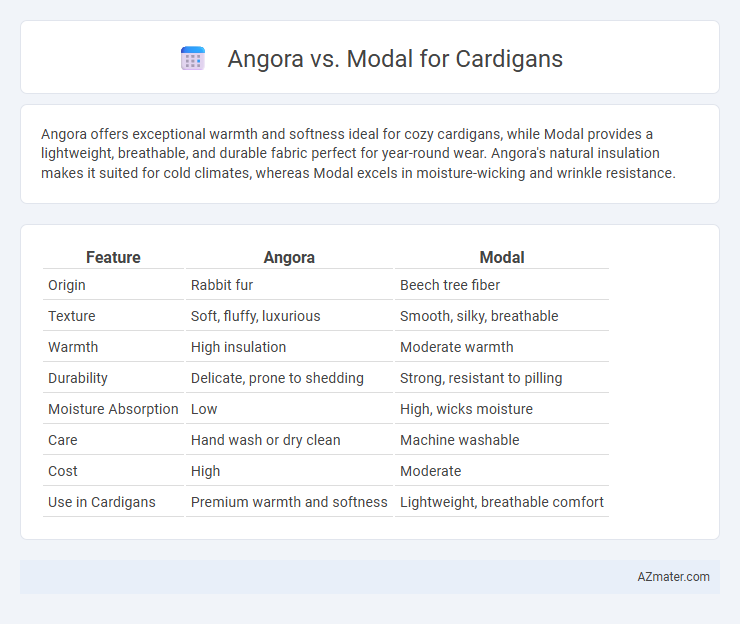Angora offers exceptional warmth and softness ideal for cozy cardigans, while Modal provides a lightweight, breathable, and durable fabric perfect for year-round wear. Angora's natural insulation makes it suited for cold climates, whereas Modal excels in moisture-wicking and wrinkle resistance.
Table of Comparison
| Feature | Angora | Modal |
|---|---|---|
| Origin | Rabbit fur | Beech tree fiber |
| Texture | Soft, fluffy, luxurious | Smooth, silky, breathable |
| Warmth | High insulation | Moderate warmth |
| Durability | Delicate, prone to shedding | Strong, resistant to pilling |
| Moisture Absorption | Low | High, wicks moisture |
| Care | Hand wash or dry clean | Machine washable |
| Cost | High | Moderate |
| Use in Cardigans | Premium warmth and softness | Lightweight, breathable comfort |
Introduction: Angora vs Modal Cardigans
Angora cardigans offer exceptional warmth and a luxurious, soft texture derived from angora rabbit fur, making them ideal for cold climates. Modal cardigans provide a lightweight, breathable alternative crafted from beech tree fibers, known for moisture-wicking and durability. Choosing between angora and modal depends on the desired balance of insulation and comfort for cardigan wearers.
What is Angora Fabric?
Angora fabric, derived from the Angora rabbit, is renowned for its exceptional softness, lightweight warmth, and luxurious texture, making it a premium choice for cardigans. Unlike Modal, which is a semi-synthetic fiber made from beech tree pulp known for its breathability and moisture-wicking properties, Angora offers superior insulation and a distinctive fluffy appearance. Angora's natural fibers provide excellent thermal regulation, ensuring cozy comfort in cooler climates while maintaining a delicate, elegant look in knitwear.
What is Modal Fabric?
Modal fabric is a type of semi-synthetic textile made from beech tree pulp, known for its softness, breathability, and moisture-wicking properties, making it an excellent choice for cardigans that require comfort and durability. Compared to Angora, which is a natural fiber derived from Angora rabbits and prized for its warmth and fluffy texture, Modal offers a smoother, cooler feel and better resistance to shrinkage and fading. Modal cardigans provide a lightweight, breathable option ideal for layering in various climates, while Angora cardigans are preferred for their luxurious warmth and softness during colder seasons.
Softness and Texture Comparison
Angora fibers offer a luxurious softness with a silky, fluffy texture that provides exceptional warmth, making it ideal for premium cardigans. Modal, derived from beech tree pulp, delivers a smooth, silky feel with excellent breathability and a lightweight drape, enhancing comfort and durability. While Angora excels in plush softness, Modal outperforms in moisture absorption and resilience, offering a balance between softness and easy maintenance.
Warmth and Insulation Properties
Angora fibers, derived from Angora rabbits, excel in warmth and insulation due to their fine, hollow structure that traps heat effectively, making them ideal for cardigans in cold climates. Modal, a semi-synthetic fiber made from beech tree pulp, offers moderate insulation but prioritizes breathability and moisture-wicking over heat retention. Cardigans made from Angora provide superior thermal comfort and softness, while Modal cardigans are better suited for mild temperatures requiring lightweight warmth.
Breathability and Moisture-Wicking
Angora fibers offer excellent breathability due to their natural crimp, which creates air pockets that enhance insulation while allowing airflow, making cardigans warm yet breathable. Modal fabric excels in moisture-wicking, efficiently drawing sweat away from the skin and drying quickly, contributing to superior comfort in humid conditions. Choosing between Angora and Modal for cardigans depends on prioritizing warmth with natural airflow or advanced moisture management for active wear.
Durability and Longevity
Angora fibers, known for their softness and insulating properties, tend to be less durable due to their delicate structure, making Angora cardigans more prone to pilling and wear over time. Modal, a semi-synthetic fabric derived from beech tree pulp, offers superior durability and resistance to shrinkage, retaining its shape and color longer through repeated washing. Therefore, for cardigan longevity and sustained appearance, Modal provides a more robust fabric choice compared to Angora.
Care Instructions and Maintenance
Angora cardigans require gentle hand washing with cold water and mild detergent to preserve fiber softness and prevent matting, while Modal cardigans can often be machine washed on a delicate cycle, allowing for easier maintenance. Both fibers benefit from air drying flat to maintain shape and avoid shrinkage, though Angora's delicate nature necessitates extra care to prevent felting. Regular brushing of Angora helps maintain fluffiness, whereas Modal demands less frequent upkeep due to its smooth, durable texture.
Eco-Friendliness and Sustainability
Angora fibers are biodegradable and renewable but often face criticism for animal welfare concerns, which impacts their overall sustainability profile. Modal, derived from sustainably managed beech trees, offers a more eco-friendly option due to its lower water usage and biodegradable properties. Choosing modal cardigans supports reduced environmental impact while angora emphasizes natural origin but requires careful ethical sourcing.
Choosing the Best Cardigan: Angora or Modal
Angora cardigans offer unmatched warmth and a luxurious, soft texture derived from angora rabbit fibers, ideal for cold weather layering. Modal cardigans provide excellent breathability, moisture-wicking properties, and a smooth, silky feel, making them perfect for year-round comfort and durability. When choosing the best cardigan, consider angora for premium warmth and softness, while modal suits active lifestyles with its lightweight, easy-care characteristics.

Infographic: Angora vs Modal for Cardigan
 azmater.com
azmater.com